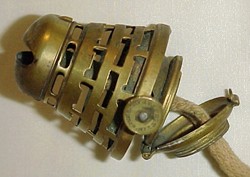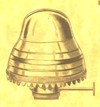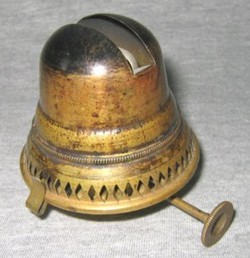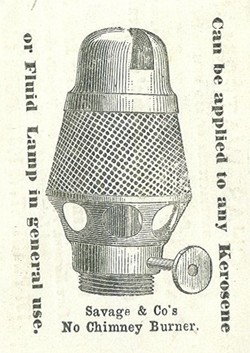As the term implies, chimneyless or "no chimney" burners are a class of burners that are designed to operate without a chimney. For the purposes of this discourse, only those designed for coal oil or kerosene will be covered. There were many other types of burners manufactured that did not require the use of a chimney including whale oil, camphene and other burning fluids, and scores of vapor burners. These burners were produced by all the major lamp makers of the period.
Many of the chimneyless burners were used extensively on dead-flame lanterns where the burner was inherently protected from stray currents by the globe and the entire lantern enclosure by design induced a draft from the base up through the lantern cap. The larger ones like the Zenith (above) and the American Diamond Light (below), were often used on chicken brooder lamps, but they were also manufactured and marketed for general use on hand and table lamps.
Chimneyless burners appeared as soon as coal oil and kerosene came into widespread use in the late 1850's and continued well into the late 1800's. During that period, there were over 150 patents granted, and there was no shortage of designs and claims. There were a number of reasons cited in the patent claims for the manufacture of a burner which did not require a chimney. Among these are reduced cost of manufacture and consumer maintenance; the purchaser need not be concerned with replacement of glass chimneys which are easily broken through use or carelessness. Most employed a "cage," cone or other enclosure of metal, either solid or perforated, that basically replaced the glass chimney by directing the flow of air inward and upward. Many burners were also specifically designed to reduce the amount of heat transferred downward from the burner into the fount through a variety of methods, thereby increasing safety by reducing the accumulation of hot vapors in the fount.
Generally, there's nothing glamorous about the large no chimney burners. They are rather boring as burners go and look out of place on most lamps. The smaller varieties, like the Dodin's patent depicted in the margin, are more appealing to the eye and look nice on a finger lamp or small hand lamp. A few nice examples will certainly help to round out a collection of lamps and trimmings! Depicted at left is the reverse of a trade card for Charles Waterman, a manufacturer and dealer in kerosene lamps from New York. This shows the SAVAGE burner patented by Orrin J. Savage & George P. Hawley, both from Ithaca, New York, on May 5, 1863; U.S. Patent Number 38,422. The SAVAGE burner is also shown in an early F.H. Lovell catalog. |
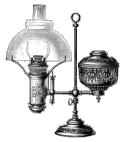
| Reference Desk | Lamp Information | Other Resources | On-Line Shopping |

Purveyors of Antique Lighting and Accessories
435 Main Street
 Hurleyville, New York 12747
Hurleyville, New York 12747
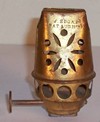 Joseph Dodin's
Joseph Dodin's patent no. 39,524. August 11, 1863, Assigned to J. Edgar. Image: eBay Auction --------------------- Enlarge image [+] |
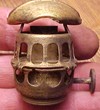 Luther C. White's
Luther C. White's patent no. 56,131. Dated July 3, 1866. Made by Benedict & Burnham Mfg. Co. --------------------- Enlarge image [+] |
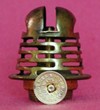 M.L. Callender burner Feb. 18, 1862,
M.L. Callender burner Feb. 18, 1862, Made by Holmes, Booth & Haydens --------------------- Enlarge image [+] |
 James Sangster burner March 25, 1865.
James Sangster burner March 25, 1865.Pat. no. 34,782 --------------------- Enlarge image [+] |
sometimes less is more...

Chimneyless Burners
^ Top of Page
Privacy Policy | Terms and Conditions of Use | Announcements
Copyright © 2001-2011 ~ Daniel Edminster | The Lampworks ~ All Rights Reserved
